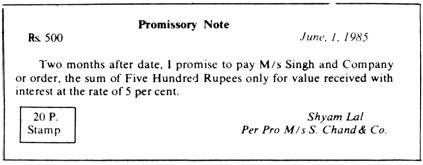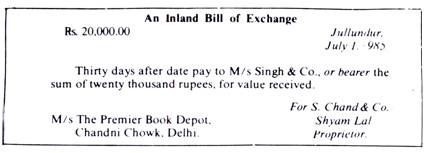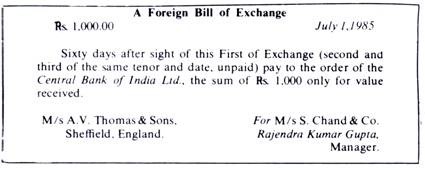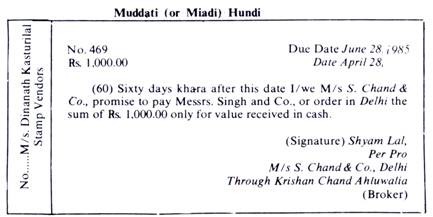Credit Instruments:
People talk a little regretfully of the good old days when everybody was honest and a man’s word was as good as his written bond. They forget that now the area of dealings has increased greatly.
Perhaps, man has become more selfish too, on account of the increase in the struggle for existence; hence almost always some record of transactions is kept in black and white.
This record may take the form of a promissory note, a bill of exchange, a cheque, a draft or a hundi.
Banks, in some countries like Great Britain, used to issue notes without check from Government. These bank notes were of the nature of promissory notes. This led to over-issue of such notes without sufficient security and resulted in frequent bank failures. This practice was too dangerous to be allowed to continue and the government had to prohibit it. Hence today only the Central Bank of a country is allowed to issue notes.
ADVERTISEMENTS:
These notes are accepted by the people because of their faith in the stability of the government, and are almost as good as money. Therefore, for purposes of our study, we may exclude them from the list of instruments of credit. By instruments of credit ate meant those documents which make possible credit transactions. Let us study the main types of credit instruments.
Promissory Note:
The simplest form of a credit instrument is the promissory note. A promissory note (or pro-note for short) is a written promise from a buyer or a borrower to pay a certain sum of money to the creditor or his order. It is what we call IOU (I owe you), i.e., an acknowledgment of debt and an obligation to repay.
A typical promissory note is as below:
The words “value received” indicates that the document is the result of some purchase or loan. Interest must be mentioned; otherwise the pro-note is not good in law. Such a document can be used for any kind of transaction, personal or commercial.
Bill of exchange:
ADVERTISEMENTS:
A bill of exchange is used in internal as well as foreign trade. It is an order by a seller to a buyer or by a creditor to a debtor to pay a certain sum of money to himself or to bearer or to another person named therein. The seller or the creditor who draws the bill is called the ‘drawer’; the purchaser or the debtor on whom the bill is drawn is called the “drawee.” The seller may order the payment to be made to a third person called the “payee”.
Specimens of inland and foreign bills of exchange are given below:
In place of the payee’s name any of these forms may be used:
ADVERTISEMENTS:
1. Pay to bearer,
2. Pay to Dr. J. D. Varma or order, or
3. Pay to my order.
When the bill of exchange begins with “On demand”, instead of “thirty days”, it is a “demand bill’ or “sight bill’.
The drawer sends ‘he bill to the drawee who “accepts” it by signing it and putting his office stamp on it. The bill now becomes a negotiable instrument and can be bought and sold in the market. The drawer can now discount it and change it into cash on paying a commission, called discount, at some firm or bank. It may pass through several hands before it ultimately matures or falls due for payment, when the drawee pays his debt by honouring the bill.
If the drawee is not very well known, he secures the services of an Accepting House to sign and accept the Bill. Such houses or firms specialize in providing guarantees and charge a commission for their services. To perform such services the Accepting Houses have to keep themselves well informed of the financial position of the merchants on whose behalf they accept bills.
Advantages of a bill of exchange:
A bill of exchange thus performs the following important functions:
ADVERTISEMENTS:
(i) “Neither the exporter nor the importer has to go without his money while the goods are in transit.—(Sayers) The exporter gets his money from a bank and the importer does not have to pay immediately. He pays it after he has sold the goods, and has funds in hand.
(ii) Funds lying idle in banks are invested in Bills of Exchange and are profitably employed. Banks particularly favour this form of investment, because money is not locked up for long and can be withdrawn easily. It is said that a good bank manager knows the difference between a bill and a mortgage. The bills discounted set up a regular stream of money flowing in and out.
(iii) Gold and silver are saved from being transported between countries. Exports are made to balance against imports through the bill market without movement of gold.
(iv) While the buyer pays in his own currency, the seller is paid in his own. Exchange Banks undertake the whole work and individuals are saved from all bother and inconvenience.
Hundis:
ADVERTISEMENTS:
We, in India, are more familiar with hundis as they are commonly used. They are internal bills of exchange in one of our own languages, and have been prevalent in India long before the dawn of civilization elsewhere. Hundis are Darshani (sight bills) and Miadi or Muddati (time bills) on the basis of the time allowed to the debtor. Hundiana is the commission sometimes deducted by the lender from the amount advanced.
Specimens of the two types of hundis used in India (translated in English) are given below:
Cheques:
ADVERTISEMENTS:
Definition:
A cheque is the most common instrument of credit and almost works like money. It is a written order on a printed form by a depositor (drawer) to his bank to pay a sum of” money to himself or to somebody else, whose name is entered on it, or to the bearer, i.e., the man who holds it (i.e., drawee). No bank ordinarily refuses to pay money for a cheque, provided it is correctly filled in, and there is enough money in the drawer’s account with the bank. A specimen cheque is given below. The counterfoil with the drawer serves as a record of the payment.
Cheques are of the following kinds:
Bearer Cheque:
Any one, who happens to have the cheque, can get it cashed. In this case, the bank need not worry as to who presents it at the counter. If a bearer cheque is lost, the finder can cash it unless the bank is notified in time to stop the payment. The drawer runs the risk of losing his money, and not the bank.
Order Cheque:
ADVERTISEMENTS:
The word “bearer” after the payee’s name is crossed out, as in the cheque form below, and the word “order” written instead. It is a safer form of payment, because the bank is responsible for paying the money to the right person. The person who presents the cheque at the counter has to prove his identity, before the proceeds of the cheque can be paid to him.
Crossed Cheque:
This is the safest form of payment as it cannot be cashed .it the bank counter. The payee cannot get the proceeds of the cheque in cash, lie can only get the sum transferred to his own or (after endorsing) to somebody else’s account. A cheque is “crossed” by drawing two parallel lines across its face or in a corner and writing the words “& Co.” between them. The specimen given above is crossed. If it is crossed “Payee’s A/c.”, then cash cannot be obtained from the bank; the amount of the cheque can only be credited to the payee’s A/c.
Post-dated Cheque:
Such a cheque is a way of making payments sometime in the future. If you have to pay a hundred rupees to a friend after a month, you may draw a cheque in his favour and put down the future date. It can be cashed only on or after that date.
ADVERTISEMENTS:
Blank Cheque:
It means an unlimited offer because the signature is put, whereas the space for the amount is left blank to be filled in by the drawee. Such cheques are usually handed over in romances or films! Nobody ordinarily signs a blank cheque.
Advantages of Cheques:
The cheque has economized the use of money. No cash need be paid. Moreover, its great convenience lies in that the payment can be exact to a paisa. There is no fear of loss when the cheque is crossed. Thus it is safe method of payment, besides being convenient. Again, the counterfoil of the cheque serves as a receipt and, therefore, ensures honesty.
The account of the transaction is with the bank and can be called for evidence, if needed. But it requires confidence in the drawer as well as the bank for acceptance. Since cheques are not legal tender, their acceptance is not compulsory.
Bank Drafts:
A cheque can also be used to remit funds to another place. But as the account is held in a different place, from where the cheque is presented, the latter branch of the bank normally gets in touch with the former before making the payment. To avoid this botheration, a banker’s draft is used.
A bank draft is a cheque drawn by a bank on its own branch or on another bank requiring the latter to pay a specified amount to the person named in it or to the order thereof. The cheapest method of sending money is through a bank draft. A bank does not usually charge more than 10 P. per hundred rupees if the amount to be sent is not less than a thousand rupees, and if it has a branch at the place of payment.
Clearing House:
One great advantage that follows from the use of cheques is that we do not have to carry a pocketful of notes or coins for our purchases. In countries, where people have developed the banking habit, rarely is a purchase paid for in cash, unless it is a very small sum. The people who are paid in cheques do not get them cashed but just pay them into their accounts at their bank. Thus, if both the persons have a common bank, a mere change in their bank balances completes the transaction.
When there are several banks in a locality and the two persons have accounts with different banks, the process is not so simple. Every bank receives during the course of the day cheques on other banks in favour of its customers. To send cash back and forth from one bank to another every day would be very troublesome. To avoid this trouble, the device of a Clearing House is used.
The representatives of the local banks meet at a fixed place after the working hours and balance their claims against one another. When simple book entries have cancelled most of the obligations, a small balance may be claimed by one bank from the other.
This is usually settled through a cheque on the Central bank (the Reserve Bank of India or the State Bank of India) with which all commercial banks have to keep accounts. There are Clearing Houses in important cities in India, the most important being those in Bomaby, Calcutta and Delhi.
Advantages of Credit:
The services rendered by credit to society are undoubtedly very great.
The following benefits of credit may be mentioned:
ADVERTISEMENTS:
(i) Credit instruments replace metallic money to some extent. This means a great economy. Expenditure is avoided on precious metals for monetary purposes. Also, there is no loss arising from wear and tear of coins.
(ii) Trade and industry are financed mostly by the aid of credit. No industrial or commercial progress would be possible if the business were to be conducted strictly on a cash basis. In the absence of credit, trade would be on a very restricted scale.
(iii) Credit makes capital more productive. It is through credit that capital is transferred from persons who cannot use it themselves to persons who are in a position to do so. Without credit facilities, a good deal of capital would have remained unused.
(iv) Credit enables banks to lend far beyond their cash reserves. Thus they are able to make profits for themselves besides helping trade and industry. The banks can in this way ‘create money’.
(v) Credit instruments like bills of exchange facilitate payments not only between people living in the same country, but also between people belonging to different countries. This facilitates and extends international trade.
(vi) Men of enterprise and business ability are enabled by credit to launch business undertakings, even though their own financial resources may be meagre. In this way, credit helps the development of trade and industry in the country. Without its aid, a good deal of business talent would have been wasted.
Abuses of Credit:
Credit is a very delicate instrument, and, as such, it has to be handled with utmost care. Unless the use of credit is kept within sensible limits, it is/likely to prove very dangerous.
The following possible evils-of credit’ may be mentioned:
(i) Reckless borrowing ruins both the borrower and the lender. A spirit of gambling is introduced in business. This is against the spiritual healthy trade.
(ii) By making it easy for a person to get funds, credit may encourage extravagance and waste. People start living beyond their means. This is indeed a very bad habit.
(iii) If the banks create credit beyond proper limits, it may encourage speculation. Over-speculation may endanger the economic stability of the country. It stands in the way of healthy development of trade and industry.
(iv) Free use of credit by the manufacturers may lead to over-production, causing depression in the industry. Depression brings business to a standstill. It causes unemployment and brings misery to the workers.
(v) Unsound businesses are kept alive by the artificial aid of credit. It is in the interest of the community that such weak links should be removed. Credit may only conceal the financial weakness of a concern.
(vi) Credit encourages the formation of monopolies by placing large funds at the disposal of a few individuals or corporations. Monopolies exploit consumers and indulge in so many other anti-social practices.






